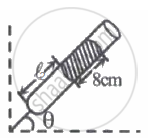Advertisements
Advertisements
Question
A student placed a gas jar containing air in the upside down position over a gas jar full of red-brown bromine vapours. He observed that the red-brown colour spread upwards into the jar containing air. Based on this observation, the student concluded that it is only the bromine vapour which moves up and diffuses into air in the upper jar, the air from the upper jar does not move down by diffusion into the lower jar containing bromine vapours. Do you agree with this conclusion of the student? Give reason for your answer.
Solution
No, the conclusion made by the student is wrong because the air from the upper gas jar also diffuses down into the lower gas jar containing bromine vapour. Since, air is colourless it cannot be noticed by the student.
APPEARS IN
RELATED QUESTIONS
Give a reason for the following observation.
We can get the smell of perfume sitting several metres away.
Name the physical state of matter which can be easily compressed.
Fill in the following blank with suitable words :
Solid, liquid and gas are the three ........................ of matter.
Give two reasons to justify that Water is a liquid at room temperature.
What does the diffusion of gases tell us about their particles?
Give reason for the following observation :
The smell of hot sizzling food reaches us even from a considerable distance but to get the smell from cold food, we have to go close to it.
A substance has neither a fixed shape nor a fixed volume. State whether it is a solid, a liquid or a gas.
Why do gases not have fixed shape?
Comment upon the following:-
shape
 |
|
| Fig. I | Fig. II |
In figure-I, an air column of length ℓ1 is entrapped by a column of Hg of length 8 cm. In figure-II length of same air column at the same temperature is ℓ2. The `ℓ_1/ℓ_2` is:
(1 atm = 76 cm of Hg)

